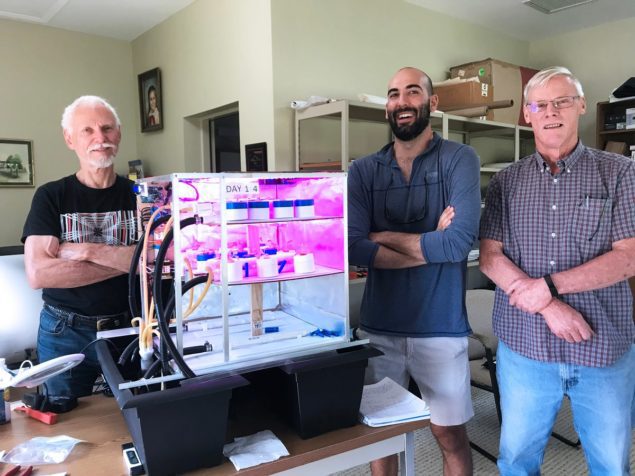|
Getting your Trinity Audio player ready...
|

Three South Florida men with diverse backgrounds — and all volunteers at Fairchild Tropical Botanic Garden — have teamed together in a unique collaboration to design a plant-growing method that they hope will someday be found on the International Space Station (ISS).
It’s all part of the nationwide Growing Beyond Earth Maker Challenge that calls for contestants in three team categories — High School, College and Professional — to submit designs for growing plants in space. Six finalists remain out of the 60 original submissions in year two of the three-year contest.
Jack Hahn, a photographer, heard about the program while working as a volunteer in the Fairchild Imaging Lab, was intrigued and submitted a proposal to grow “veggies in space that do well in microgravity.” His proposal impressed the judges — Dr. Gioia Massa, NASA Plant Research; Trent Smith, NASA Procurement, and Ralph Fritsche, NASA Veggie Project Manager — and he became one of the six finalists in the Professional (non-collegiate) category.
According to Dr. Carl E. Lewis, Fairchild Tropical Botanic Garden director, each year of the competition is intentionally getting more challenging.
“We have been involved in this program with NASA for years, after conversations about the challenge of growing plants in space,” Lewis said. “Year One was about how to make the best use of limited growing volume on a space craft. This year is about automation. Can you set it and forget it? Next year will be about robotic planting and harvesting. We’re looking forward to seeing what you [contestants] come up with.”
After Hahn was selected for phase two of the competition, the Kendall resident realized he needed more assistance.
“I was very excited to hear that I was a finalist,” said Hahn, husband of Marjorie Hahn, executive and music director of the South Florida Youth Symphony. “But I realized that I needed to put together a team with various skill-sets and talents to go further.”
So, in May, Hahn met with the other two Fairchild volunteers who responded to an email he sent — Coconut Grove’s Nic Brunk, a molecular biologist (and crew coach for the Miami Beach Rowing Club), and Shenandoah’s Allen Diehl, a photographer with a degree in mechanical engineering.
Their goal is to grow high-density vegetables (with a high Vitamin K benefit) in a limited amount of space (a 50 cm cubic growing environment) using an autonomous system that won’t require any further human interaction (after initial seed planting) over a 30-day period.
Together, the three South Florida “scientists” have come up with an eye-catching design (with the limited constraints on size per NASA’s specs) that, well, looks like something from outer space. It has three levels (heights) for the difference phases of growth of the red romaine lettuce most competitors are using.
And, in a bold move they hope will impress the judges — and be used in future growth models in space — the threesome is growing their plants hydroponically.
“Even though you think of ‘weightlessness’ in space, weight is everything, including in the space shuttle bringing supplies to the ISS,” Brunk said. “Soil is weight and messy to deal with, especially in space.”
Diehl said, “Hydroponics is definitely the way to go. It eliminates the soil factor, and you can recycle or repurpose the water.”
Basically, the automation model the threesome has developed works by small computer, which turns the growing lights on/off, and activates fans and pumps. Additional automation to replenish the nutrient solution levels will follow.
But all three agree that the small monetary prize which awaits the winner of the NASA/Fairchild collaboration, which will be announced in July/August of this year, is not the reason for the countless hours of sometimes tedious work.
“This competition will provide NASA with valuable input and data, which will someday enable those on the International Space Station as well as Moon and Mars missions with a means of complimenting their diet while giving them something live and green to look at in a sterile environment,” Hahn said. “It will be great to know that our team had something to do with that.”





